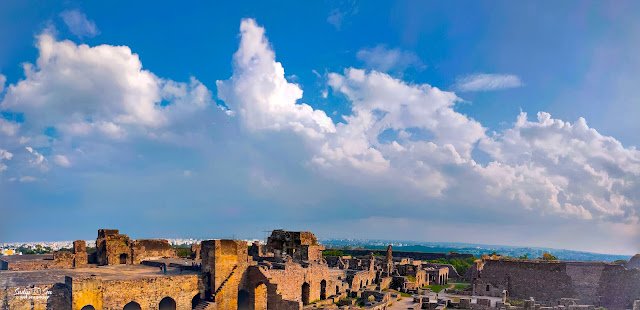From Secunderabad railway station we took a bus to reach Mehdipatnam and from there we changed another bus to reach the Golconda fort .
We hired a professional guide for a better understanding about the history of the Golconda fort .
The fort is a silent sentinel to the passing of the reign from one dynasty to the other .
It it is said that the name Golkonda came from the local language which means the shepherds hill.
The fable goes by ,that once a shepherd found an idol of a lord from the place where the fort is located. This news quickly reached the Kakatiyas and they built a small mudfort at this place , as a sign of a holy place . As time passed by Rani Rudramadevi and then her grandson Pratap Rudra started expanding the fortification.
When the Kakatiya rule came to an end with the attack of Alauddin Khilji, it went to the hands of the Bahamanis . The Bahamani ruler had appointed the merchant Sultan Quli, as the governor of Telangana. When the Bahamani kingdom also lost the power Sultan Quli declared himself an independent ruler and founded the Qutub Shahi dynasty in 1518 .They added the title of Shah as they were Shia Muslims .
He then started fortifying the existing structure with the naturally rich granite rocks.
Quli Qutub Shah even after becoming the ruler continued his trading business . The garden at the right side , where free drinking water taps are there , used to be the place where precious stones and pearls were traded. In Persian language diamond is called Nagina, and hence the place was called Nagina Bazaar or the diamond market .
The Golconda fort is rich with surprising secrets. At the entrance we witnessed with awe, the echo of clapping reverberating at far distance.
A unique design can be seen in the ceilings of different rooms . Some are only for visual appeal ,while some are designed scientifically to play with the sounds .
The guide should us and different points that have the sound of a clap could easily be heard from a far distance. It acted as a system of the present day calling bell . we were spellbound by the innovative idea of the ancient times .
The most intriguing and interesting parts were when the guide showed us , how the movement of clothes echoed so loudly and how whispers facing the wall could be heard by another person standing at least 40 feet away .
It seemed none less than magic .
Quli Qutub Shah had built a mosque atop the granite hill of Golconda in 1518 . There was a terrible plague during the reign of Muhammad Quli , he prayed to Allah and his prayers were answered, so he laid the foundation of Charminar, imitating the same design of this mosque in Golconda fort.
The fort also holds the story of two Hindu courtesans , Taramati and Bhagmati , to whome the 4th ruler, Mohammad Quli Qutub Shah event gifted two palaces.
Bhagamati was an excellent singer . She was singing bhajans which was incidently heard by Muhammad Quli , who at once fell in love with her.
He named the city as Bhagya Nagar after Bhagmati .
Bhagmati converted to Islam ,and seeing her reciprocated love for Muhammad Quli, he brought her to the palace and renamed her as Hyder Begum from whose name the city of Bhagyanagar was renamed as Hyderabad .
The renowned diamonds present at different parts of the world were mostly mined from the Golconda region . It was so rich in producing and trading precious stones ,that the name Golconda had once become synonymous to wealth.
The Deccan region is rich in black soil, which produces good quality of cotton .So this region also flourished as a chief exporter of cotton clothes to different parts of the world .
The name and fame of this ancient fort declined abruptly with the devastating seige of eight months held by Aurangzeb, when the Mughal army totally destroyed the fort .
Till this date three creations of three dynastys exist in this fort - the Kali Temple of Kakatiyas , the mosque of the Bahamanis and the stone fort of the Qutub Shahi dynasty .











.jpg)
.jpg)

0 Comments
Post a Comment